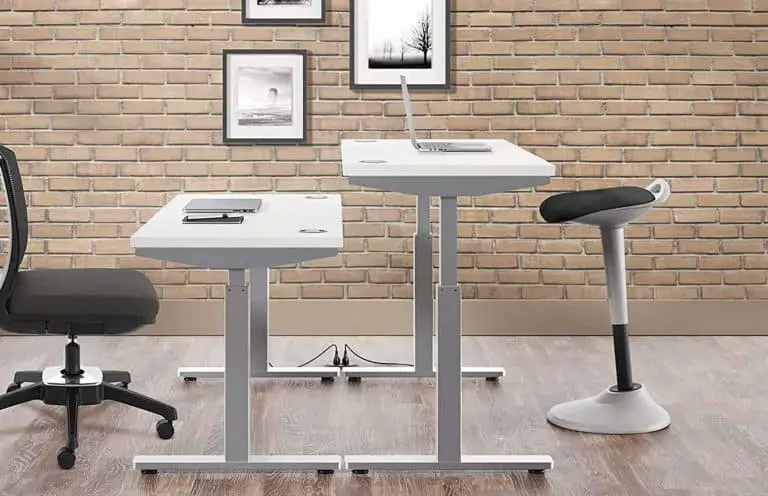Did you know there’s a lot more benefits of sit-stand stools than making life easier when working behind a standing desk?
These backless perch stools are genuine must-haves in all kinds of situations such as; workshops, ateliers, laboratories, or teachers in class rooms. Just to name a few. The reason? They boost health and productivity.
Sit to stand stools are great to use as portable seating when giving presentations or during a congress too.
Of course, any serious standing desk user needs a sit-stand stool, too. Have you ever tried standing behind a desk all day long?
It’s torture. And even if you’re trained (used to it) it can get old at times. Which is why sit stand stools offer the best of both worlds.
Sit or stand when you feel like it. Or when the situation asks for it. Some tasks are better performed while seated while others benefit from standing up. By being able to alternate between sitting and standing you’ll keep your legs and back fresh.
Sit stand stools vs perching stools – what’s the difference?
A sit stand stool is simply a stool on which you can either sit on or use as a standing stool. When used as a standing stool you’re not technically standing but perching (somewhere in between sitting and standing) thus a more apt name would be sit-perch stool.
Perching: “to sit on or near the edge of something / to be in a high position or in a position near the edge of something”.
Sit stand stools are sometimes referred to as perching stools but be aware that not all perching stools are sit stand stools. This because not all perching stools can be lowered.
Before the introduction of the standing desk, traditional perching chairs were known as those seats commonly used as independent living aids for the elderly and disabled.
Various sit to stand stool models are, besides adjustable, ergonomically designed establishing a gently sloping yet comfortable seat that makes prolonged standing easier and healthier while reducing the risks of excessive sitting. Recent research* shows there’s sufficient evidence to promote sit-stand stool use in various industries. One of the conclusions; “sit-standing reduced lower limb discomfort and improved vascular outcomes”.
Active siting with sit stand stools
All forms of active sitting engage your muscles by encouraging your body to take a more natural stance. Sit stand stools do this in a subtle way while avoiding slouching and slumping. Many users with lower back problems indicate they experience less back strain during and after maintaining the perching position.
1. Alera Adaptiv Ergo perch sit stand stool
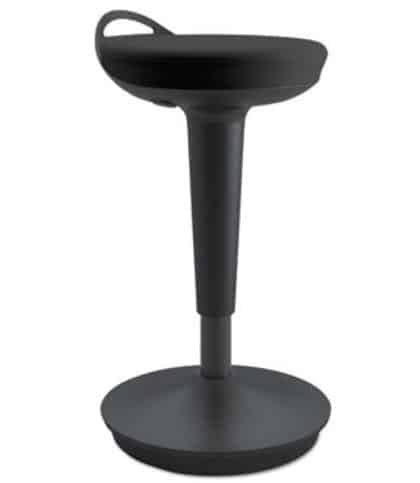
Instead of having a flexible joint that allows it to move, like most sit-stand stools, the Alera has a slightly rounded bottom to the base to introduce instability. This allows you to rock and tilt if you want to, but sitting with your weight centered will keep the seat perfectly steady.
This is ideal if you’ve not used sit-stand stools before and are worried about being unable to keep still. The stool rotates through 360 degrees and there’s waterfall padding all the way around the edge, so your legs will be comfortable whatever angle you sit at.
The Alera’s frame has a wide handle integrated into the back so you can lift it easily. The pneumatic lifting mechanism is smooth and efficient, operated with a one-touch button under the base of the seat.
2. Aimezo sit stand desk stool
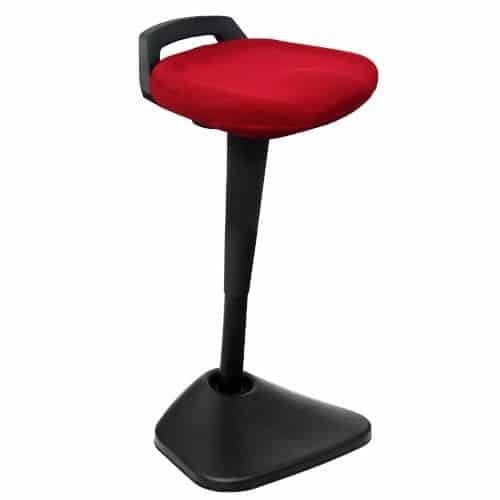
With a height adjustable from 26” to 36” and a maximum weight of 220lbs, the Aimezo is great for tall people, who often find that sit-stand stools don’t go up high enough. The jointed design allows you to lean, pivot, and tilt while sitting for active core engagement.
The Aimezo seat isn’t centered above the base: instead, the stool leg is angled slightly forward to put your weight towards the back of the base. This takes a bit of getting used to, because when you first look at the stool it looks like it’s going to topple forwards.
However, once you’ve sat on it a few times, you’ll realize that this slightly uneven weight distribution actually makes the base feel much more stable when the seat is raised.
3. Hon sit to stand stool
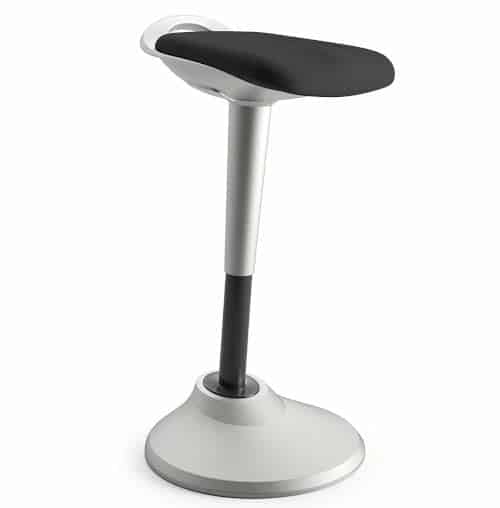
At 15 by 15 inches, the Hon stool has one of the largest and most comfortable seats we’ve seen in any sit-stand stool. The seat tilts slightly forward, helping to put your pelvis perfectly in line with your spine, and it has waterfall padding along the front edge to reduce pressure on the backs of your thighs while leaning.
The entire thing weighs only 9lb – you could carry it with two fingers. The low seat back also acts as an integrated handle, making the stool easy to move.
The base tilts in four directions, and allows up to 360 degree rotation for a full range of motion. As the base lies flat against the floor, rather than being rounded, you don’t have to engage all your core muscles just to keep it stable.
Many users see that aspect of the Hon stool as a positive thing, since it’s more comfortable to use for long periods of time, but others prefer the extra core engagement that comes with an unstable base.
4. Learniture Active Learning sit stand stool
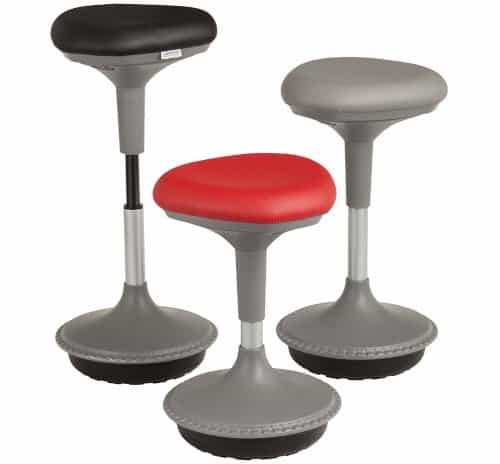
This Learniture stool is a well-kept secret. It’s marketed as study furniture for high-schoolers, which means that it’s tough and relatively cheap, but it’s large enough for an adult to use and you get great quality for your money.
The curved non-slip base allows you to rock from side to side while sitting, which many people find helps them with concentration. It also allows you to tilt forward while working, so you can lean over your desk or squint at your computer screen without pulling your back out of alignment. (Here’s an overview of the best rated wobble seats.)
The seat cushion has an unusual rounded triangle shape, which many people find is more comfortable as it allows their legs to hang down slightly while sitting.
Be aware that the Learniture is really an adjustable stool rather than a sit-stand stool, so it won’t be tall enough to use with a standing desk for taller users. However, some users claim that if you’re about 6′ you can use the stool at its highest point as an active standing chair.
The height adjusts from 18”-28”, which for most people will be a raised-up sitting position rather than a standing perch. With that caveat, this is one of the best-quality active sitting stools at the lower-cost end of the market.
5. Aeris Muvman sit stand stool
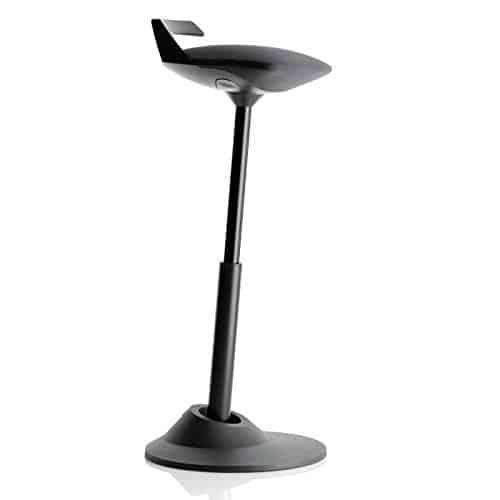
Most sit-stand stools on the market are built for the average-sized person, which is usually taken to be a 5’10” man. If you’re under 5’6” or over 6’2”, you’re likely to find that some stools on the market just aren’t comfortable for you. The Muvman gets around this common problem by making two different sizes, regular (adjustable 20”-33”) and tall (24”-36”).
The pneumatic lift is activated by a flat button underneath the seat. It takes a little adjustment to get to the ideal height, but once you’re there, this is one of the most comfortable models on the market.
The base allows about 4 degrees of tilt in any direction, with a slow, smooth tilting motion. This 4 degrees is just enough freedom to allow you to wriggle around and stay active, while still allowing you to sit securely and stay comfortable.
6. LeanRite Elite sit stand stool
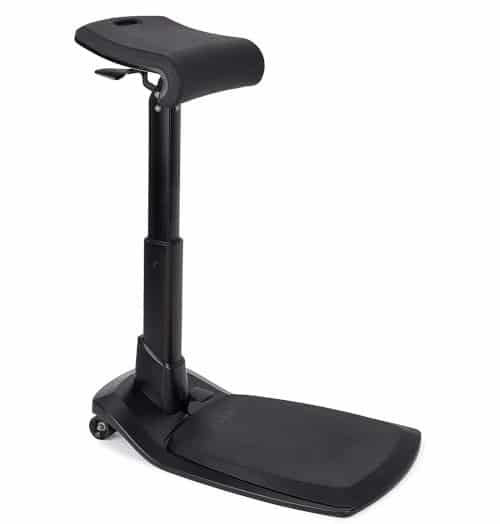
The LeanRite is an innovative take on the sit-stand stool. In addition to adjusting the seat height, you can also fix the seat at three different angles – flat, 15 degrees, or 45 degrees. 15 degrees provides a gentle tilt which helps to ease your spine into alignment when sitting; 45 degrees is perfect for lumbar support while standing.
The seat also features a padded, molded front edge: this means that when the seat is flat, you have the option of leaning your center back against the narrow edge rather than putting your butt against the seat. This is a great option for those who feel tail-bone numbness when in a traditional sit-stand chair.
The stool actually combines two useful ergonomic devices, by having an anti-fatigue mat incorporated into the base. This means that you can use it all day without getting sore feet or ankles. At 37lbs, it’s not at all portable, but it is strong and stable. LeanRite‘s weight limit is 270lb and it goes up to 43” high, meaning it’s ideal for big or tall people.
7. Safco Twixt sit stand stool
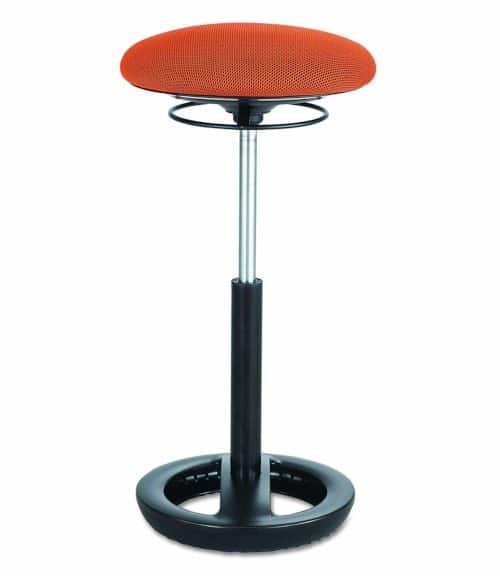
A lot of ergonomic furniture looks very…ergonomic. Things like sit-stand stools are usually designed for office use, so you see a lot of unsexy grey plastic and practical wipe-clean pleather. In orange, green, or blue, the Safco Twixt really stands out from the crowd.
Instead of a one-sided pneumatic lift, there’s a slim black ring underneath the seat, which not only looks elegant but means you can adjust the height from any direction.
But it’s not just a good-looking item. The Twixt is stable and practical, with 360 degree rotation and a patented flexible ring underneath the chair base allows you to sit, lean, or perch. It’s also designed to be easily portable, with a finger groove under the seat and a weight of just 14lbs.
8. Varidesk adjustable standing desk chair
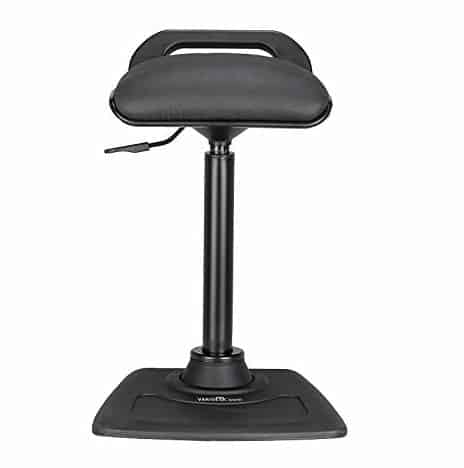
This stool is a premium product; it’s one of the most expensive sit-stand stools on the market, but you get great quality for your money. The articulating pedestal allows a dynamic range of motion, letting you rock from side to side or rotate the seat through 360 degrees, and the pneumatic lift will rocket you to any height between 23” and 33” at the touch of a finger.
In addition to all the usual benefits of a sit-stand stool, the Varidesk standing desk chair has extra features to further encourage good posture. There’s a low back which slopes gently out of the seat, guiding your pelvis into the tilted-forward position which is best to keep your spine aligned.
The extendable leg leans forward at a very slight angle, meaning that you feel better supported when leaning and don’t need to clench your muscles to hold your position.
Health benefits of sitting or perching on a sit stand stool
Thanks to improved ergonomics there are quite a few ways in which you can improve your health by using a sit stand stool. Not only will your body thank you, chances are you will be more productive, feel better, are less tired at the end of the work day,
You’ll train your core muscles
While seated on a normal chair your core muscles tend to completely relax and, after a while, lose strength. Quickly and effortlessly switching from sitting to standing lets you alternate between relaxing and flexing your core and back muscles. When standing with the support of a standing support stool, your muscles are stimulated to keep your torso in proper posture which helps keep muscles fit.
You’ll move more
Increased mobility throughout the day is thought to mitigate some of the risk associated with sitting for extended periods of time.
Your range of movement is extended
When in leaning mode your reach is increased and thus you’re able to cover a larger work surface while reducing the risk of overextending.
Less knee strain
Perching reduces knee joint strain as switching from this position to standing up straight is virtually effortless when compared to getting up from a traditional chair.
Increased mental alertness
Sitting up straight as well as maintaining an open core stance increases cardiovascular activity. Which in turn boosts brain oxygenation which enhances mental alertness.
Reduced risk on poor circulation in the legs
Standing for prolonged periods of time causes inactivity of the lower leg muscles which is known to decrease blood flow which may result in pain and or swelling. When perching or leaning on a sit-stand stool you’re encouraged to flex your upper and lower leg muscles, thus improving circulation.
Improves core body circulation
While seated on a conventional chair (90º angle) circulation of blood and fluids to and through the internal organs is restricted. Leaning in an upright posture mitigates these adverse effects promoting the cardiovascular and digestive systems. The upright position also reduces possible digestive obstructions and allows for the diaphragm to move without restraint.
Less risk on lower back pain
Standing with flat feet for long periods of time is strenuous on the lower back as it’s working continuously. This very fact is one of the reasons why sit stand stools are healthy alternatives to traditional seats. However, too much of a good thing is, well, you know. Especially when your lower back muscles are not as strong (yet) but even in the more trained individual the following is likely to happen after a while. Lower back muscles tire, your back arches or curves, which may result in abnormal bent back posture (a.k.a. lordosis or swayback).
Bad posture, specifically unnatural curvature of the lower back, is common among seated workers which is why making the transition to a standing working position could worsen posture, and thus fatigue and pain.
A sit stand stool (a.k.a. perching stool, leaning stool) is designed to tilt your pelvis a little bit forward thus promoting a healthy position of the spine in its natural slightly curved S-shape. Which enhances stability, strength, and support of the whole body while banishing the common, unnatural curvature.
References
* Comparing standing posture and use of a sit-stand stool: Analysis of vascular, muscular and discomfort outcomes during simulated industrial work. Source: ScienceDirect.com
Featured image: HON sit to stand backless stool/ perch stool for office desk.
Last Updated on September 4, 2022 by Tyler

